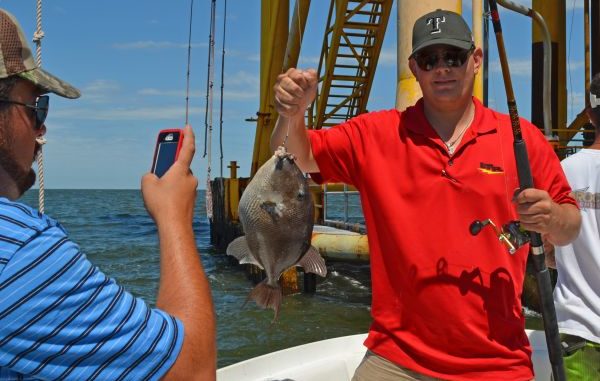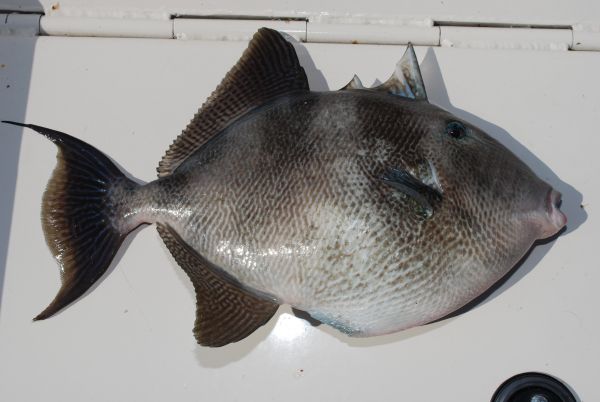
Drab, mottled gray, buck-toothed, big-headed and pig-eyed — a gray triggerfish wouldn’t fit anyone’s definition of cute or beautiful. Inexperienced offshore fishermen who reel in one of these charmers at an offshore oil platform will usually stare at their catch clueless as to what it is.
Gray triggerfish are the most common of six species of triggerfish found in the Gulf of Mexico. Less-common members of the family include the absolutely gorgeous queen triggerfish, the ocean triggerfish, the rough triggerfish, the sargassum triggerfish and the black durgon.
The latter three are less common in the northern Gulf of Mexico and, in fact, the black durgon (one of the few jet-black fish in the world) is listed in most fish references as only being found in the southern Gulf. We know that it exists here, however, because remote cameras have captured their presence at hard-bottom locations off our coast.
Wherever they are found in the world, members of the triggerfish family are associated with hard bottom — natural or artificial reefs. Probably the most-famous member of the family is the colorful humuhumunukunukuapua\’a, the wedge-tail triggerfish, voted the official state fish of Hawaii. The name, which means “fish that grunts like a pig” is supposed to be one of the longest words in the Hawaiian language.
Triggerfish get their name from their large, dorsal fin spines. The first spine is massive — for a reason. When threatened, the fish will dive into a tight space, wedge itself in and erect the spine, which locks into place. The erect spine is so rigid that human hands can\’t apply enough pressure to collapse it. But if the second spine, the one that locks the large first spine upright, is depressed like a trigger, the big spine comes down with ease.
The gray triggerfish is listed as occurring from Nova Scotia, Canada, to Argentina, but their peak of abundance is in the Gulf of Mexico and the Caribbean. Wherever they are found, fishermen prize them as a food fish. Their flesh is white, very firm and mild-tasting.
Getting to that meat is the challenge. One writer described their skin as “concrete-like.” Cutting through it as is done in filleting other species is not an option. Rather, the knife must be inserted into the flesh in the groove along-side the dorsal fin and then the fish must be filleted from the inside out.
One of the features that adds to their peculiar appearance are their very small mouths with almost inflexible jaws. A peek inside their mouths reveals a lot about what triggerfish do for supper: Their diet of choice is mostly hard-shelled things — crabs, sea urchins, sand dollars, starfish, barnacles and mussels.
Gray triggerfish have been observed on the hunt for sand dollars over open, sandy bottoms, where they take head-down vertical positions a few inches above the bottom. The fish blow streams of water toward the bottom with enough force to stir up the sand, exposing any sand dollars present.
When a sand dollar is spied, the fish darts in and grabs it in its beak-like mouth, lifts it above the bottom and drops it. It repeats the maneuver until the sand dollar lands upside down. The fish then takes a vertical position over the hapless creature, and with its jaws closed plunges downward, crushing the center of the sand dollar. The fish then eats the sand dollar\’s soft innards at its leisure.

The gray triggerfish has a quirky life cycle. Unlike other reef-oriented species, gray triggerfish spawn in nests, depressions that male fish scoop out of the bottom. Individual males have been known to construct multiple nests and lure several females to them for spawning, which takes place from July through September.
During that period, females will spawn multiple times. A Gulf of Mexico study showed females spawning as many as 24 times a season, yielding an average of 17 million eggs. A south Atlantic study conflicts with the Gulf study, showing only three to four spawns per female per year.
The nests are vigorously guarded, even against human skin divers, until the eggs hatch in 48 to 55 hours. Hatchling triggerfish show unexpected behavior: Instead of taking shelter in bottom habitat, they swim to the surface as soon as they become mobile, seeking patches of floating sargassum seaweed.
They are often found in very large numbers in sargassum, where they feed on small fish, crustacean and barnacle larvae, worms, hydroids and algae. In turn, they serve as an important food source for oceanic predatory fish — most especially dolphin, but also billfish — that frequent the beds of seaweeds.
By the fall, when the young gray triggerfish are 5 to 7 inches long, they swim down as much as 180 feet, taking up residence on a spot of hard bottom from which they seldom range far.
Just how loyal gray triggerfish are to the spot they settle in was illustrated in a study done off the Alabama coast. The researcher caught, tagged and released 1,235 fish from 7 to 21 inches long. Artificial reefs produced 201 triggerfish, of which 40 were recaptured once, two were recaptured three times and three were recaptured four times. This was a very high rate of recapture.
But the rate of recapture was even higher from natural reefs. Of a total of 1,034 fish, 226 were recaptured once, 35 twice, eight were recaptured three times, three fish were recaptured four times and one either very dumb or very aggressive fish was recaptured five times. Overall, 90 percent of the fish were recaptured within 3 miles of where they were tagged.
Triggerfish fishing is best in spring and fall, and poorest during spawning season and in the winter. The National Marine Fisheries Service and the Gulf of Mexico Fisheries Management Council has decreed gray triggerfish to be both overfished and still undergoing overfishing.
A focused fishery for the animals has never really developed off of Louisiana and Texas, but apparently fishing pressure has been greater in the eastern Gulf. The average ages of gray triggerfish from the two areas seems to bear this out. In the eastern Gulf, the average age is 2 to 3 years old. In the western Gulf, the average is 5 to 7 years old.
Under the National Marine Fisheries Service\’s one-size-fits-all formula, if a species is overfished in one part of the Gulf, it is overfished everywhere. Gray triggerfish mature at age 2 and can live to 13 years old.
Gray triggerfish catch quotas, based on fishing history, allocate 81 percent of the Gulf of Mexico catch to recreational/charter fishermen and 19 percent to commercial fishermen.


